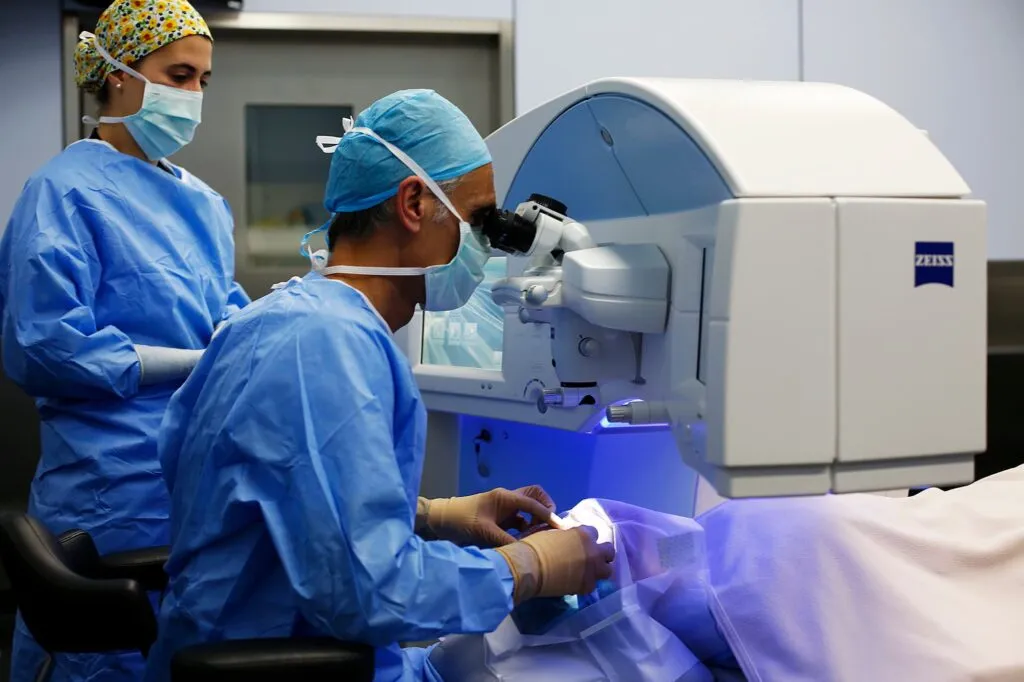
Refractive surgery for myopia: advanced solutions at Miranza
Myopia is one of the most common refractive errors and a leading cause of wearing glasses or contact lenses worldwide. At Miranza, we offer refractive surgery treatments that safely, effectively, and permanently correct myopia—providing a real alternative to improve quality of life and visual independence.
What is myopia?
Myopia is a refractive error that occurs when the eye focuses images in front of the retina instead of directly on it. This causes blurry distance vision while nearby objects remain clear. The condition often has a hereditary component but can also be influenced by environmental factors such as excessive screen use or lack of natural light. Its prevalence is increasing, particularly among young people.
What is refractive surgery and how can it correct myopia?
Refractive surgery includes a set of surgical procedures designed to correct refractive errors like myopia by altering the curvature of the cornea or implanting an intraocular lens. Techniques such as LASIK, PRK, SMILE, or ICL help focus light correctly on the retina, reducing or eliminating the need for glasses or contact lenses. At Miranza, we offer personalized care using cutting-edge technology tailored to each case.
Criteria to be a good candidate for refractive surgery for myopia.
Not everyone with myopia is a suitable candidate for refractive surgery. An initial consultation is needed to assess factors such as age, corneal thickness, prescription stability, the presence of astigmatism, or other eye conditions. Ideal candidates are generally over 18, with stable myopia and good overall eye health.
Types of refractive surgery that can treat myopia
Corneal Laser Techniques
LASIK
The LASIK technique involves lifting a flap of corneal tissue, applying the laser underneath, and repositioning the flap. Its main advantage is quick visual recovery with minimal discomfort. It is not recommended for very thin or irregular corneas.
PRK-LASEK
In this technique, the corneal epithelium is removed to apply the laser directly. Although recovery is slower and may involve more discomfort, it is ideal for thinner corneas or patients at higher risk with LASIK.
SMILE
A minimally invasive technique that removes a lenticule from within the cornea through a micro-incision. It offers excellent corneal stability and a lower risk of dry eye. Ideal for moderate to high myopia.
Phakic Intraocular Lenses (ICL)
When laser surgery is not viable—due to thin corneas or very high prescriptions—phakic intraocular lenses can be implanted. These lenses correct vision without altering the cornea and are placed without removing the natural lens. They are reversible and offer excellent visual quality.
The myopia surgery process at Miranza
Initial consultation and preoperative tests
Includes a full assessment with corneal topography, pachymetry, intraocular pressure, and general eye health evaluation. This helps determine the safest and most effective technique for each patient.
Preparing for surgery day
Patients are advised not to wear contact lenses for a few days, to come makeup-free and with a companion. All relevant procedure information is provided beforehand.
Surgery day
The procedure is performed using anesthetic eye drops and lasts between 10 and 30 minutes. It is outpatient, and after a short rest, patients can go home
Immediate postoperative care
Avoid rubbing your eyes, follow the prescribed eye drop treatment, and attend all scheduled follow-ups. Vision improves progressively, especially in the first few days.

Recovery from refractive surgery for myopia
Recovery time varies depending on the technique. With LASIK and SMILE, most patients regain good vision within 24–48 hours. PRK may take a few extra days. Temporary blurry vision, light sensitivity, or a gritty sensation are normal. Complete recovery includes follow-up visits to ensure proper healing of the operated eye.
Potential risks and complications
Although refractive surgery is safe, risks include dry eye, night halos, regression of the correction, or the need for enhancement. Serious complications are rare if the patient is properly evaluated and postoperative instructions are followed. At Miranza, medical expertise and advanced technology minimize these risks.
Why choose Miranza for your myopia surgery with refractive techniques?
Miranza is a leading ophthalmology provider in Spain. Our team of specialists offers a comprehensive approach—from the first consultation to full discharge. We use the latest advances in eye surgery and customize each treatment to meet our patients’ needs. We are committed to medical excellence, personalized care, and maximum safety.
Frequently asked questions about myopia surgery with refractive techniques
Does the surgery hurt, regardless of the technique?
No. Topical anesthetic eye drops are used, and the procedure is painless, although some techniques may cause mild temporary discomfort.
How long does the surgery take?
The procedure takes between 10 and 30 minutes and is performed on an outpatient basis.
Can both eyes be operated on at the same time?
Yes, in most cases both eyes are treated in the same session to simplify recovery.
Can astigmatism be corrected along with myopia in the same procedure?
Yes. Most techniques allow for the simultaneous correction of myopia and astigmatism.
Are the results of the surgery permanent?
Generally, yes. However, minor changes can occur over time, especially if the myopia was not fully stable before surgery.
Is there any guarantee on the results of myopia surgery?
Results are highly satisfactory in the vast majority of cases. At Miranza, we offer ongoing follow-up and additional treatments if necessary.